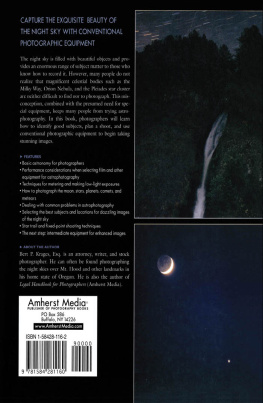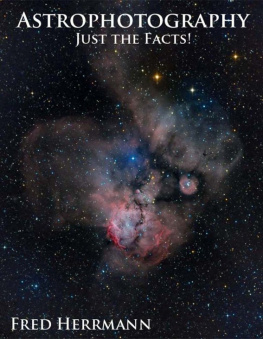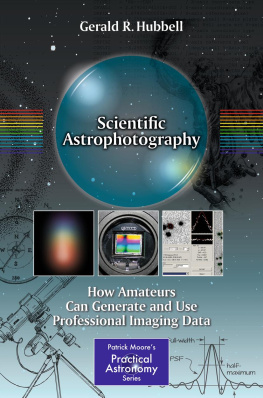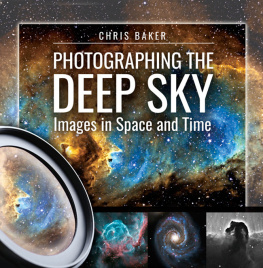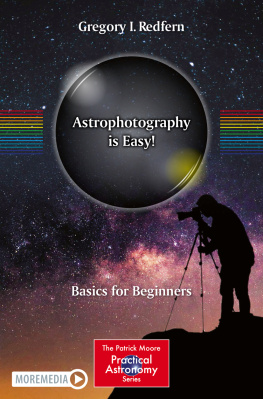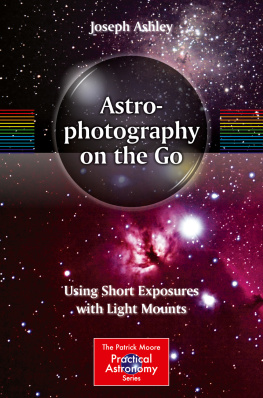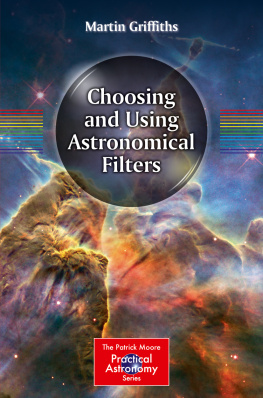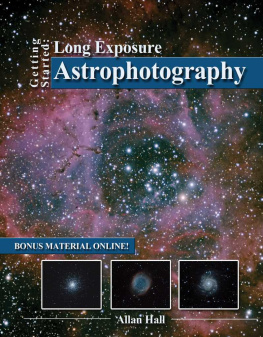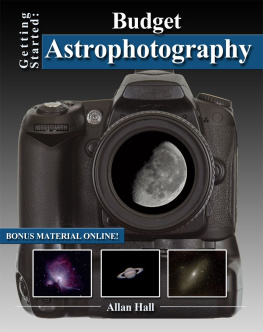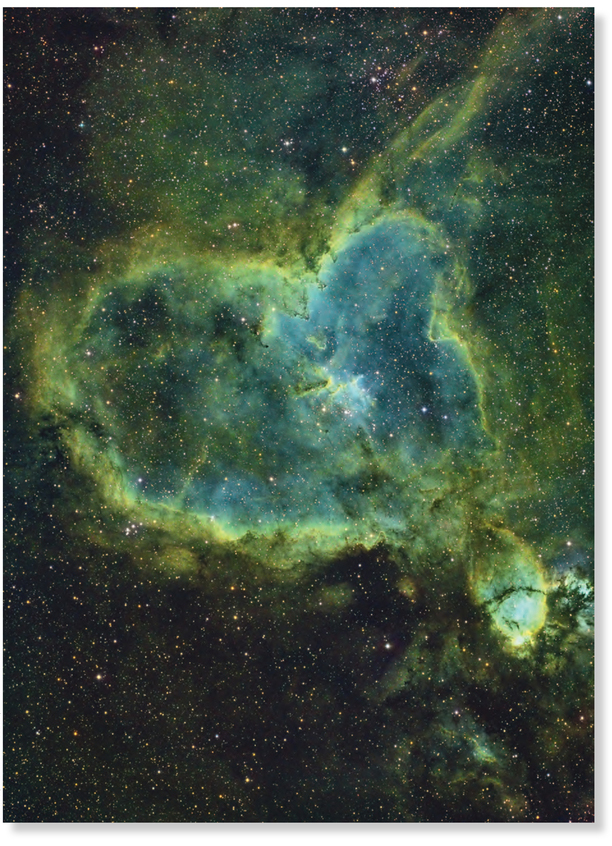The Astrophotography Manual
A Practical and Scientific Approach to Deep Space Imaging
Chris Woodhouse
First published 2016
by Focal Press
70 Blanchard Road, Suite 402, Burlington, MA 01803
and by Focal Press
2 Park Square, Milton Park, Abingdon, Oxon OX14 4RN
Focal Press is an imprint of the Taylor & Francis Group, an informa business
2016 Chris Woodhouse
The right of Chris Woodhouse to be identified as author of this work has been asserted by him in accordance with sections 77 and 78 of the Copyright, Designs and Patents Act 1988.
All rights reserved. No part of this book may be reprinted or reproduced or utilized in any form or by any electronic, mechanical, or other means, now known or hereafter invented, including photocopying and recording, or in any information storage or retrieval system, without permission in writing from the publishers.
Notices
Knowledge and best practice in this field are constantly changing. As new research and experience broaden our understanding, changes in research methods, professional practices, or medical treatment may become necessary.
Practitioners and researchers must always rely on their own experience and knowledge in evaluating and using any information, methods, compounds, or experiments described herein. In using such information or methods they should be mindful of their own safety and the safety of others, including parties for whom they have a professional responsibility.
Product or corporate names may be trademarks or registered trademarks, and are used only for identification and explanation without intent to infringe.
Library of Congress Cataloging in Publication Data
Woodhouse, Chris.
The astrophotography manual: a practical and scientific approach to deep space imaging / Chris Woodhouse.
pages cm
Includes bibliographical references and index.
1. Astronomical photography. I. Title.
QB121.W87 2015
522'.63--dc23
2014047121
ISBN: 978-1-138-77684-5 (pbk)
ISBN: 978-1-138-91207-6 (hbk)
ISBN: 978-1-315-77301-8 (ebk)
Typeset in Adobe Garamond Pro and Myriad Pro by Chris Woodhouse
www.digitalastrophotography.co.uk
Contents
"Don't Panic"
Douglas Adams
As a child, I was interested in astronomy and contented myself with identifying the major constellations. It was the time of the Apollo missions and the lunar landings in the early '70s. In those days, amateur telescopes were a rarity and even binoculars were an indulgence for a young boy. My first book on astronomy was a Hamlyn guide. I still have it today and it is a quaint reminder of how we viewed the universe and the availability (or lack thereof) of sophisticated amateur equipment. Today, this guide is notable by its lack of photographic illustrations and belongs to the era of the technical illustrator. As a teenager, a family friend showed me the Moon and Saturn through a homemade Newtonian reflector. It wobbled on a wooden tripod and required something resembling alchemy to re-silver the 6-inch mirror that lay at its heart. I still have a black-and-white print of the Moon taken with that telescope. It is a testament to the dedication and practical necessities of early astrophotographers.
In the '90s the seed was sown by a local astronomer who gave a slide presentation at my photographic club: It was my first glimpse of what lay beyond the sensitivities of the human eye and at a scale that completely surprised me. Those images were on Kodak Ektachrome and although I am saddened by the demise of classical photography and values, I have to concede that modern digital sensors are responsible for making astrophotography a vibrant hobby.
Up until this time I was completely engrossed by photography, especially traditional fine-art monochrome. Just like the early astrophotographers, I found that necessity was the mother of invention. I designed and later patented various darkroom accessories and researched film-based photography for many years. At the same time I started technical writing: I started with a few magazine articles and progressed to full scale reference books on traditional photography. I had yet to point a camera at the night sky.
Fast-forward to the present day and we are in the midst of an exponential interest in astrophotography in all its forms. Recent popular television series, Mars expeditions and the availability of affordable high-quality telescopes and cameras have propelled the fascinating world of amateur astrophotography. This surge of interest in a way mirrors the explosion of digital imaging in the prior decade, but unlike modern digital photography, astrophotography still appeals to those with a practical mind and handy skills more than those with a large bank balance, though it is safe to say, it certainly helps.
In 2011, I took the plunge into the deep end. I was awestruck by what was possible, at the beauty and variety of the many images on various websites that I had previously supposed were the work of professional observatories. As I grappled with this new hobby, I found many books were out of date on digital imaging techniques and others were useful overviews but without sufficient detail in any one speciality. Thankfully, the many friendly astronomy forums were a source of inspiration and I quickly appreciated just how much there was to learn and go wrong. The other forum members and I were asking similar questions and it highlighted the need for a book that stepped through the whole process of setting up, capturing and processing images. It occurred to me I had a unique opportunity to document and share my steep learning curve and combine it with my photographic and technical skills.
I have already owned several systems, in addition to using many astronomy applications for Mac OSX, Windows and Apple iOS. It is too soon to call myself an expert but it is a good time to write a book while the research and hard lessons are still fresh in my mind. During this time the constant patient support of my family has provided the opportunity for research and writing.
So, in the year that Sir Patrick Moore, Bernard Lovell and Neil Armstrong passed away, I hope to inspire others with this book in some small way and improve the reader's enjoyment of this amazing hobby through their success. The early chapters include a brief astronomy primer and a nod to those incredible early pioneers. These set you up for the technical and practical chapters and give an appreciation of achievements, past and present. The technical chapters start by looking at the practical limitations set by the environment, equipment and camera performance. After several practical chapters on the essentials, equipment choice and setting up, there are several case studies. These illustrate the unique challenges with practical details and using a range of software. An extensive index, glossary, bibliography and supporting website add to the book's usefulness and progression to better things. Clear skies.
Chris Woodhouse 2013
IC1805 (The Heart Nebula)
"The story so far:
In the beginning the Universe was created.
This has made a lot of people very angry and been widely regarded as a bad move." Douglas Adams
Chris was born in Brentwood, England and from his teenage years was fascinated by the natural sciences, engineering and photography, all of which he found more interesting than football. At the weekend he could be found building or designing some gadget or other. At school he used a slide-rule and log books for his exams at 16. Two years later, scientific calculators had completely displaced them. He studied Electronics at Bath University and by the time he had completed his M.Eng., the computer age was well under way and 8-bit home computers were common. After a period designing military communication and optical gauging equipment, as well as writing software in Forth, Occam, C++ and Assembler, he joined an automotive company.


